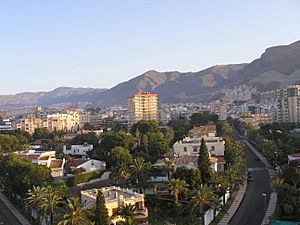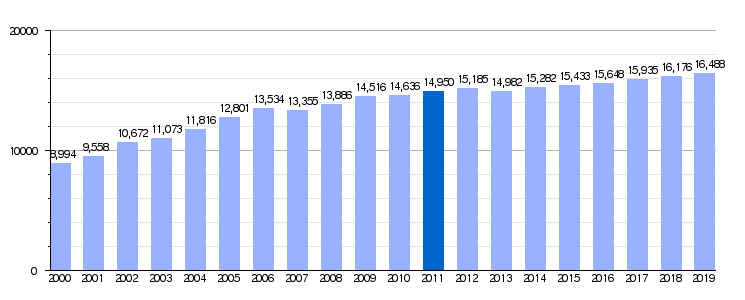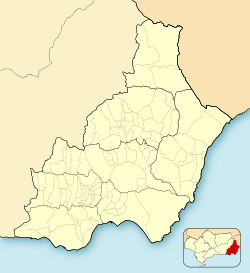Aguadulce (Almería) facts for kids
Quick facts for kids
Aguadulce
|
|
|---|---|
 |
|
| Country | Spain |
| Region | Andalusia |
| Province | Almería Province |
| Comarca | Poniente Almeriense |
| Municipality | Roquetas de Mar |
| Elevation | 2 m (7 ft) |
| Population | 16,176 inhabitants |
| Website | www.aytoroquetas.org |
Aguadulce is a lovely Spanish town. It is part of the Roquetas de Mar area in the Almería Province. This province is located in the Andalucía region of southern Spain.
Aguadulce is in the Poniente Almeriense area. It is about 14 kilometers (9 miles) from the city of Almería. You can reach it by the national road (N-340a) or the main highway (A-7). In 2018, about 16,176 people lived there. But in summer, this number can triple! This is because many tourists visit, making tourism the town's main activity.
Contents
History of Aguadulce
How Aguadulce Joined Roquetas de Mar
The towns of Aguadulce, Las Hortichuelas, and Campillo del Moro were not always part of Roquetas de Mar. They joined in the early 1900s. The town council of Enix, which owned these areas, offered to give them to Roquetas de Mar. This was if Roquetas de Mar paid off Aguadulce's debts.
The people of Aguadulce were told about this plan. No one objected. So, on June 24, 1927, the Roquetas Town Council agreed to add Aguadulce. In 1928 and 1929, the borders were set. A part of the Vícar area was also added.
However, in 1931, the Enix Town Council asked for their land back. Roquetas agreed at first. But then, a person from Aguadulce protested. In 1932, the Roquetas Town Council decided to keep Aguadulce. This led to many disagreements between the two towns.
Life in Early Aguadulce
Aguadulce was more populated than El Parador. It had over 200 homes. Most houses were along the main road (N-340a). Some streets went up towards the mountain. There were a few important houses for that time. The town had a simple gas pump, a grocery store, and a small chapel. These were the most notable places.
Modern Changes and Growth
In the early 1900s, new things came to Aguadulce. A new road was built. Communication improved with telephones and telegraphs. The first bus line started. In 1936, a workers' group called "Desde la Buena Unión" brought electricity for public lighting. Aguadulce was growing. It had two schools and celebrated its patron saint, the Virgen del Carmen.
Aguadulce Becomes a Tourist Hotspot
Tourism began to grow in Aguadulce. In 1964, Aguadulce was named the "First National Interest Center of Spain." This meant it was a special place for tourism. Early visitors did not stay in fancy hotels. They rented or bought simple homes in the town. They would build small huts on the beach to enjoy the sun and sea. These huts were taken down after their holidays.
Aguadulce grew a lot. In 1950, it had only 27 houses and 300 people. Today, it has over 15,000 residents. In summer, this number can reach about 45,000 people!
Recent Developments
In April 2019, a group called "Aguadulce en Marcha" was formed. It is led by Francisco Javier García Fernández. Their goal is to solve local problems. They also want Aguadulce to become an "Entidad Local Autónoma." This means it would have more control over its own local government.
Demography
Population evolution
The chart below shows how the number of people living in Aguadulce has changed over the years.
| Vertical bar chart demographic of Aguadulce (Almería) between 2000 and 2019 |
 |
Transport and Communications
Aguadulce is well-connected. The Mediterranean Highway (A-7) links it to the rest of Almería Province and all of Spain. The old N-340a also runs through the town. It connects Aguadulce to the city of Almería and nearby towns like El Parador de las Hortichuelas and Roquetas de Mar.
The closest airport is about 25 kilometers (15 miles) away. For sea travel, Aguadulce has its own marina. The main commercial port of Almería is only 8 kilometers (5 miles) away. Aguadulce does not have its own train station. However, the Almería railway station is very close. Buses from there connect directly to Aguadulce.
Art, Monuments, and Sites of Interest
La Ribera de Algaida Archaeological Site
One important place is the archaeological site of La Ribera de Algaida. It is also known as Ribera de Turaniana. This site holds ancient remains found in 1859. The findings cover a long period of history. They start from the end of the Bronze Age and include the Argaric culture. It was also very important during Roman times and the Muslim period.
The site is located along the coast. It covers an area of about 12 to 13 hectares (30-32 acres). La Ribera de la Algaida was recognized as an "Asset of Cultural Interest" (BIC). This means it is a protected historical site. It was officially declared an Archaeological Zone on September 17, 1991.
See also
 In Spanish: Aguadulce (Almería) para niños
In Spanish: Aguadulce (Almería) para niños




